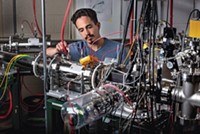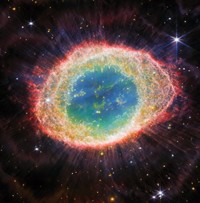Advertisement
Grab your lab coat. Let's get started
Welcome!
Welcome!
Create an account below to get 6 C&EN articles per month, receive newsletters and more - all free.
It seems this is your first time logging in online. Please enter the following information to continue.
As an ACS member you automatically get access to this site. All we need is few more details to create your reading experience.
Not you? Sign in with a different account.
Not you? Sign in with a different account.
ERROR 1
ERROR 1
ERROR 2
ERROR 2
ERROR 2
ERROR 2
ERROR 2
Password and Confirm password must match.
If you have an ACS member number, please enter it here so we can link this account to your membership. (optional)
ERROR 2
ACS values your privacy. By submitting your information, you are gaining access to C&EN and subscribing to our weekly newsletter. We use the information you provide to make your reading experience better, and we will never sell your data to third party members.
Astrochemistry
Reactions: Some history on models of the atomic nucleus
March 4, 2024
| A version of this story appeared in
Volume 102, Issue 7
Letters to the editor
Some history on models of the atomic nucleus

I read with great interest the article by Katherine Bourzac “Divining the Mysteries of the Atomic Nucleus” in the Jan. 29, 2024, issue of C&EN (page 30).
Curious readers might like to know that an excellent semitechnical review of nucleosynthesis in the universe was published by Jennifer A. Johnson in Science on Feb. 1, 2019 (DOI: 10.1126/science.aau9540). It is called “Populating the Periodic Table: Nucleosynthesis of the Elements” and in figure 1 has a periodic table showing how elements are made in the universe. The periodic table in the C&EN article is almost identical.
As a bit of history, on page 32, Bourzac says, “In the 20th century, physicists and chemists settled on a basic picture of the atom. At the dawn of the 1900s, the electron had been discovered. Since scientists knew atoms were electrically neutral, they pictured atoms as blobs with electrons and positively charged particles all mixed up and packed together”—what we call the plum-pudding model. “Ernest Rutherford and his collaborators proved this wrong,” Bourzac says. I once asked Peter Debye if they took the plum-pudding model seriously. He said no, they really had no idea what was going on.
Why was the plum-pudding model proposed? It was known that in classical electrodynamics, an accelerating charged particle gives off radiation, as given by the Larmor formula. Since an electron circling a nucleus is accelerating, it should give off radiation and spiral into the nucleus. After Rutherford discovered the planetary model of the atom, Niels Bohr explained this violation of the Larmor formula by postulating that the electron could be in only certain energy levels and could jump between these levels, at which time radiation is given off. There is a lowest energy level called the ground state. The spectral lines of hydrogen show this very nicely.
Thanks again for this and all the other wonderful articles you publish.
Harvey F. Carroll
Lake Forest Park, Washington




Join the conversation
Contact the reporter
Submit a Letter to the Editor for publication
Engage with us on Twitter